

Altered neural connectivity in excitatory and inhibitory cortical circuits in autism. Neural Systems Laboratory, Department of Health Sciences, Boston University, Boston, MA, USA.
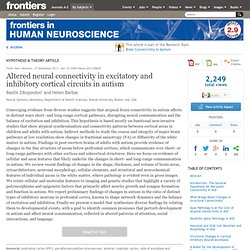
The Amsterdam Resting-State Questionnaire reveals multiple phenotypes of resting-state cognition. Introduction The growing use of resting-state neuroimaging has greatly improved our knowledge of the spatiotemporal character of ongoing brain activity in health and disease.

The observation of a highly active distributed set of brain regions during low-demanding tasks—referred to as the default mode network—has been particularly influential in the development of this field (Raichle et al., 2001). Many other resting-state networks (Damoiseaux et al., 2006; Smith et al., 2009) and their interactions (Fox and Raichle, 2007; Doucet et al., 2012) have since been described. Also the complex temporal dynamics of ongoing activity has received a great deal of interest (Linkenkaer-Hansen et al., 2001; He, 2011; Hardstone et al., 2012) with recent studies showing that that intrinsic neuronal dynamics during rest can predict individual variability in behavior (Palva et al., 2013; Smit et al., 2013).
A potentiated startle study of uncertainty and contextual anxiety in adolescents diagnosed with autism spectrum disorder. Research Paul D Chamberlain, Jacqui Rodgers, Michael J Crowley, Sarah E White, Mark H Freeston and Mikle South For all author emails, please log on.

Paper Finds Genetic Overlap For 5 Major Psychiatric Disorders. An international team has found evidence of substantial overlap for genetic risk factors shared between bipolar disorder, major depressive disorder and schizophrenia and less overlap between those conditions and autism and attention deficit-hyperactivity disorder (ADHD).
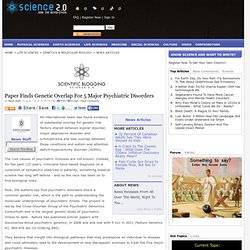
The root causes of psychiatric illnesses are not known. Instead, for the past 125 years, clinicians have based diagnosis on a collection of symptoms observed in patients, something medical science has long left behind - and so the race has been on to find biological links. Now, the authors say five psychiatric disorders share a common genetic link, which is the path to understanding the molecular underpinnings of psychiatric illness. Oxytocin, the 'love hormone' may have relevance in autism. Asperger's And Autism: Researchers Find Brain Differences. By Bahar Gholipour, Staff Writer Published: 08/05/2013 08:21 AM EDT on LiveScience Children with Asperger's syndrome show patterns of brain connectivity distinct from those of children with autism, according to a new study.
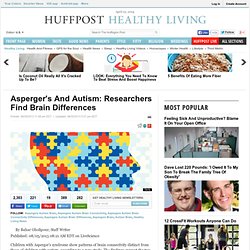
The findings suggest the two conditions, which are now in one category in the new psychiatry diagnostic manual, may be biologically different. The researchers used electroencephalography (EEG) recordings to measure the amount of signaling occurring between brain areas in children. Viewpoint: 10 jargon phrases used for my autistic son.
24 July 2013Last updated at 00:01 ET By Mark Neary Guest blogger Mark and Steven Neary My son Steven is 23.
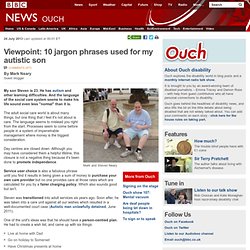
He has autism and other learning difficulties. And the language of the social care system seems to make his life sound even less "normal" than it is. The adult social care world is about many things, but one thing that I feel it's not about is care. Day centres are closed down. Service user choice is also a fabulous phrase until you find it results in being given a sum of money to purchase your own care provider but no one provides care at those rates which are calculated for you by a fairer charging policy.
Scientists identify key to learning new words. Scientists identify key to learning new words Posted on 23/07/2013 Direct connections between auditory and motor areas (red fibres) in the human brain are dedicated to functions underlying word learning.
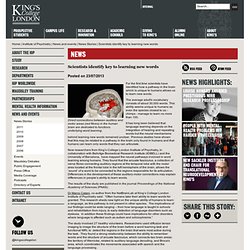
For the first time scientists have identified how a pathway in the brain which is unique to humans allows us to learn new words. Undifferentiated facial electromyography responses to dynamic, audio-visual emotion displays in individuals with autism spectrum disorders - Rozga - 2013 - Developmental Science. Kids with autism don't copy 'silly' actions. When imitating the behavior of an adult, children with the developmental disorder autism tend to skip "silly," unnecessary actions, while those without autism tend to copy everything they see, silly or not, a new study suggests.

The study involved 31 children with an autism spectrum disorder, and 30 typically developing kids without autism. All the children were asked to watch as an adult showed how to remove a toy (a rubber duck) from a closed Tupperware container. Some of the steps performed were necessary, such as unclipping the lid of the box and taking the lid off, while some were unnecessary, such as tapping the lid twice.
The children were then given the container, and asked to get the toy out as fast as they could. Kids without autism were much more likely to copy the unnecessary steps, even though the children were not specifically instructed to copy everything the adult did. The researchers now want to study more precisely what kinds of actions kids copy, Hamilton said. Current Biology - Children with autism do not overimitate.
To view the full text, please login as a subscribed user or purchase a subscription.
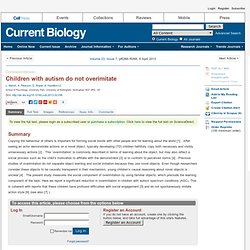
Click here to view the full text on ScienceDirect. Figure 1 Performance of all children on the overimitation and rationality discrimination tasks. (A) Number of trials where the unnecessary action was copied (maximum 5) in TD and ASC participants. Cognitive granularity: A new perspective over autistic and non-autistic styles of development - Kozima - 2013 - Japanese Psychological Research. Abstract Individuals with autism generally show better performance on operating physical objects than in communicating with people.
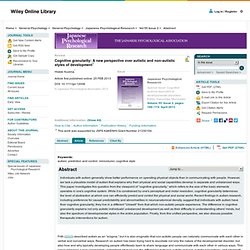
However, we lack a plausible model of autism that explains why their physical and social capabilities develop in separate and unbalanced ways. This paper investigates this question from the viewpoint of “cognitive granularity,” which refers to the size of the basic elements operable in one's cognitive system. While it is constrained by one's perceptual and motor resolution, cognitive granularity determines the level of abstraction at which one can efficiently predict and control the physical and social world. Global/Local Processing in Autism: Not a Disability, but a Disinclination - Online First. The skin-brain axis and autism?
Correlation between autism diagnosis and organic food sales. When the world becomes 'too real': a Bayesia... [Trends Cogn Sci. 2012. Trends in Cognitive Sciences - Alternative Bayesian accounts of autistic perception: comment on Pellicano and Burr. The Neurocritic: Savoir Faire or Savant? Is amygdala volume correlated with social network size or with special talents in autism spectrum disorders?
Or both?? The amygdala is a subcortical structure located within the medial temporal lobes. Journal of Autism and Developmental Disorders, Online First™ Temporal discounting of monetary rewards in children and adolescents with ADHD and autism spectrum disorders - Demurie - 2012 - Developmental Science. Consciousness as the key to our mental traits. Clare Wilson, features editor In The Ravenous Brain Daniel Bor explores consciousness and suggests that its level of activity is linked to several psychiatric conditions It is a long-standing philosophical conundrum: is consciousness somehow separate from the physical world or merely an illusion conjured up by our complex brains?
It took his father's stroke to convince Daniel Bor which side he was on. Bor, who had previously been considering a PhD in the philosophy of mind, opted instead for one in the neuroscience of consciousness. Impaired social brain network for processing dynamic facial expressions in autism spectrum disorders. Altered integration of speech and gesture in children with autism spectrum disorders - Hubbard - 2012 - Brain and Behavior.
Zinc and Autistic Spectrum Disorders. Autistic spectrum disorders are complicated and most likely caused by a number of different problems. However, we still don’t know definitively if something in the diet could influence autism. The following study can’t answer that question due to the design, but it does point out some interesting links: Infantile zinc deficiency: Association with autism spectrum disorders . In this study, nearly 2000 children with autistic disorders had hair tested for zinc deficiency. 584 (29.6%) subjects had levels lower than two standard deviations below the mean of the reference range. 43.5% of the male children ages 0-3 and 52.5% of the female children 0-3 in the sample were zinc deficient.
Older children with autism in the study had a lower incidence of zinc deficiency, which continued to decrease with the age of the subject sample, to the point where autistic children over the age of 10 had normal zinc levels. But measuring a mineral deficiency is more tricky than it might appear. Affective Responses by Adults with Autism Are Reduced to Social Images but Elevated to Images Related to Circumscribed Interests. Individuals with autism spectrum disorders (ASD) demonstrate increased visual attention and elevated brain reward circuitry responses to images related to circumscribed interests (CI), suggesting that a heightened affective response to CI may underlie their disproportionate salience and reward value in ASD. To determine if individuals with ASD differ from typically developing (TD) adults in their subjective emotional experience of CI object images, non-CI object images and social images, 213 TD adults and 56 adults with ASD provided arousal ratings (sensation of being energized varying along a dimension from calm to excited) and valence ratings (emotionality varying along dimension of approach to withdrawal) for a series of 114 images derived from previous research on CI.
The groups did not differ on arousal ratings for any image type, but ASD adults provided higher valence ratings than TD adults for CI-related images, and lower valence ratings for social images. Figures. In my shoes - Aspienaut - WIRED differently. Rare Genetic Illness May Shed Light on Role of Hormones in Autism, Anxiety. By Rick Nauert PhD Senior News Editor Reviewed by John M.
Grohol, Psy.D. on June 25, 2012 A new study involving children with Williams syndrome (WS) suggests that improved regulation of oxytocin and vasopressin may someday improve care for autism, anxiety, post-traumatic stress disorder and WS. WS results when certain genes are absent because of a faulty recombination event during the development of sperm or egg cells. Virtually everyone with WS has exactly the same set of genes missing (25 to 28 genes are missing from one of two copies of chromosome 7). “The genetic deficiencies allow researchers to examine the genetic and neuronal basis of social behavior,” said Ursula Bellugi, Ph.D., a co-author on the paper. Cognition and cannabis: from anecdote to advanced technology. John C. M. Brust + Author Affiliations. 'Trust' hormone oxytocin found at heart of rare genetic disorder. The hormone oxytocin - often referred to as the "trust" hormone or "love hormone" for its role in stimulating emotional responses - plays an important role in Williams syndrome (WS), according to a study published June 12, 2012, in PLoS One.
The study, a collaboration between scientists at the Salk Institute for Biological Studies and the University of Utah, found that people with WS flushed with the hormones oxytocin and arginine vasopressin (AVP) when exposed to emotional triggers. Are Atheists More Autistic Than Believers? In most religions, and arguably anything worth being called a religion , God is not just an impersonal force or creator.
Cognition and behavior: Reward circuit abnormal in autism — SFARI. Turning Kanner’s model of autism upside-down « what is autism anyway? The genetics of autism spectrum disorders. Autism is a complex neurodevelopmental disorder, marked by multiple symptoms that include atypicalities in: Autism, Ethics and the Good Life: an introduction. Monday 2nd April was World Autism Day and to mark the occasion I attended a conference at the Royal Academy entitled Autism, Ethics and the Good Life. The conference was convened by Pat Walsh, Centre of Medical Law and Ethics, King’s College London and Professor Francesca Happé, Institute of Psychiatry, King’s College London, with support from the British Academy.
The demand for places was such that the conference had to relocate from the British Academy to a larger venue at the Royal Academy. Cold and Lonely. Seth Mnookin: Autism Roundtable: Cross-Disability Solidarity, Goals for the Future, and What it Means to "Fit in" Note: This is the second part of a feature that began two days ago on the Public Library of Science. The introduction to both parts is identical. Prenatal testosterone linked to increased risk of language delay for male infants, study shows. Why Do People Yawn? You're more likely to catch a yawn from a relative than a stranger.
Model empathy — SFARI. Trained Peers Better at Aiding Autistic Kids with Social Skills. Using Skin-Cell Research to Probe Cellular Basis of Autism. How Mutations May Lead to Schizophrenia, Bipolar Disorder. Autistic Brains Grow More Slowly. IQ Testing Underestimates Autism Spectrum Intelligence. Lost and Tired » 10 Things my Autistic kids wished you knew. New Genetic Links Found Between Schizophrenia, Bipolar Disorder. Genetic Link Between Epilepsy and Schizophrenia. Children with autism demonstrate superior change detection skills. The Autism Crisis. The curious case of the reversed pronoun. PTSD Impairs Detection of Emotional Cues. Study finds new ADHD genes, links susceptibility with autism and other neuropsychiatric conditions.
Baroness Greenfield's contribution to autism science. Does X Mark the Spot for ASD? Rearranging the Introversion-Extroversion Schema. New brain imaging research reveals why autistic individuals confuse pronouns. How the brain assigns objects to categories. Social deficits associated with autism, schizophrenia induced in mice with new technology.
Brain Connectivity, Or Head Movement? People at darker, higher latitudes evolved bigger eyes and brains. Brain Imaging Can Diagnose Autism in Most Infants. Older people find it harder to see the wood for the trees. Your Bad Teacher Experiences Can Make Your Child’s Teachers Better. Speed limit on babies' vision. ARC: Whats New. Biomarker for autism discovered. Autism research centre. Infants learn to transfer knowledge by 16 months, study finds. Rhesus monkeys have a form of self awareness not previously attributed to them. This picture will make it more likely that you'll seek help. The Role of Anxiety Master. Researchers find master switch for adult epilepsy. A neuropsychological perspective on procrastination. Natural approach to treating child’s autism shows promise.
Why Celebrities Like Katy Perry Don’t Want People to Make Eye Contact. Love Hurts…For Real. Each Half of the Brain Has Its Own Memory Storage. Brain Basis for Emotion Recognition Deficits in Depression. Sight requires exact pattern of neural activity to be wired in the womb. Weaker brain 'sync' may be early sign of autism. Face-blindness solution found by Ayrshire optician. Toddlers won't bother learning from you if you're daft. How we come to know our bodies as our own. Does Everyone Have ADD? Concentration Interruptus and "Pseudo ADD" It's Different for Girls. Monkeys might be more logical than we think. Field Guide to the Loner: The Real Insiders. New study locates the source of key brain function. Babies Are Capable of Complex Reasoning.
Pervasive microstructural abnormalities in autism: a DTI study. Why Do Autistics Score Poorly On The Eyes Test? Aspergers, Bullying and Self-advocacy. Scientists Afflict Computers with Schizophrenia to Better Understand the Human Brain. Why people with schizophrenia may have trouble reading social cues. Genetic variations of the melatonin pathway in patients with attention deficit and hyperactivity disorders - Chaste - Journal of Pineal Research. Language learning: Researchers use video games to crack the speech code. Genetic Mutations Linked to Autistic Spectrum Disorders. Tiny variation in one gene may have led to crucial changes in human brain. Aspergirls.